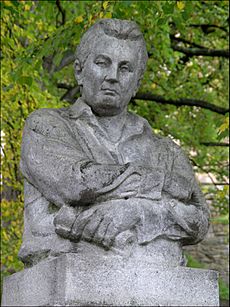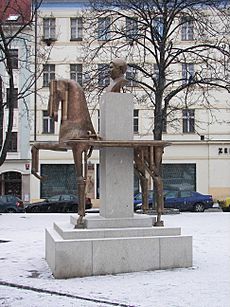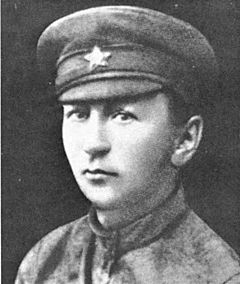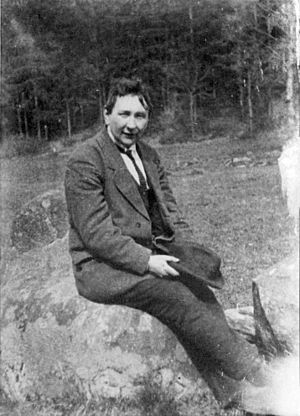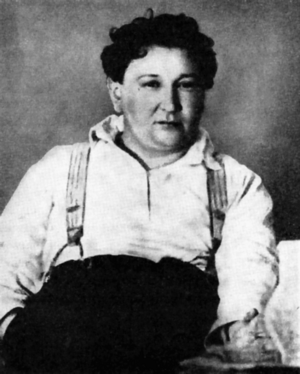Jaroslav Hašek facts for kids
Quick facts for kids
Jaroslav Hašek
|
|
|---|---|
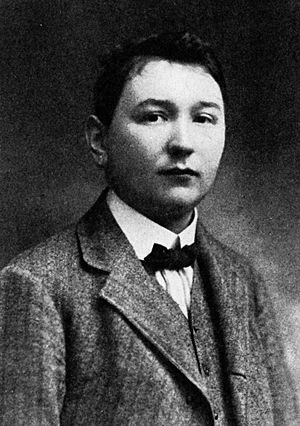 |
|
| Born | 30 April 1883 Prague, Austria-Hungary |
| Died | 3 January 1923 (aged 39) Lipnice nad Sázavou, Czechoslovakia |
| Occupation | Novelist, humorist |
| Language |
|
| Genre | Historical satire |
| Literary movement | Social realism |
| Notable works | The Good Soldier Švejk |
| Signature | |
Jaroslav Hašek (1883–1923) was a Czech writer famous for his great sense of humor. He was a satirist, which means he used humor to point out the flaws in society. He is best known for his novel The Good Soldier Švejk. This unfinished book tells the funny story of a soldier during World War I. The novel makes fun of authority figures and has been translated into about 60 languages. It is the most translated novel in Czech literature.
Contents
Early Life
Jaroslav Hašek's family came from South Bohemia, a region in the Czech Republic. His grandfather, František Hašek, was a politician who was involved in the Prague uprising of 1848.
His father, Josef Hašek, was a mathematics teacher who died when Jaroslav was young. After his father's death, his mother, Kateřina, struggled with poverty. The family had to move more than fifteen times.
As a child, Jaroslav had a heart condition. He spent a lot of time in the countryside with his grandfather and his younger brother, Bohuslav. The two brothers became very close and enjoyed traveling together on foot.
Education and First Steps as a Writer
Hašek started high school but was forced to leave after he was arrested during protests in Prague. He then worked as a druggist's assistant before graduating from a business academy. He got a job at a bank but soon left to become a full-time writer and journalist.
He began to live a "bohemian" lifestyle, which meant he didn't follow normal conventions and loved adventure. He and his brother traveled through places like Slovakia and Poland, and Hašek wrote stories about their trips for newspapers.
Career and Personal Life
For a time, Hašek was involved with anarchists, people who believed in living without strict government rules. He even edited an anarchist magazine called Komuna.
He fell in love with Jarmila Mayerová. Her parents did not approve of his adventurous lifestyle, so Hašek tried to settle down. He got a job as an editor for a magazine about animals called The Animal World. He also started his own business selling dogs, which he called the "Cynological Institute." This experience later inspired some of his funny stories.
Hašek and Jarmila married in 1910. However, their life together was difficult. After a personal crisis that led to a short hospital stay, Jarmila returned to live with her parents.
A Party for Fun
In 1911, Hašek and his friends created a fake political party called The Party of Moderate Progress Within the Bounds of the Law. They did this to make fun of real politicians and elections. It was all a big joke, but it showed Hašek's clever sense of humor. He even wrote a satirical book about the party's "history."
War and Adventure in Russia
When World War I began, Hašek was drafted into the Austro-Hungarian army in 1915. He was sent to fight on the Eastern Front.
In September 1915, he was captured by the Russian army. In the prison camp, he joined the Czechoslovak Legion. This was a group of Czech and Slovak soldiers who wanted to fight for their own independent country.
Later, Hašek disagreed with the leaders of the Legion. He decided to join the Red Army, the army of the new communist government in Russia. In Russia, he was seen as a capable and responsible organizer. He worked as a writer for army magazines and even became a commander of a unit.
Hašek returned to the newly independent country of Czechoslovakia in 1920 with his second wife, Alexandra, whom he had met in Russia. Back in Prague, some people didn't trust him because of his time with the Red Army. Feeling unwelcome, he moved to the small town of Lipnice nad Sázavou.
The Good Soldier Švejk
In Lipnice, Hašek began writing his most famous work, The Good Soldier Švejk. By this time, he was very ill. When he became too weak to write, he dictated the story from his bed.
Jaroslav Hašek died of heart disease on January 3, 1923, before he could finish the novel.
The Good Soldier Švejk is a humorous novel about a simple, cheerful Czech soldier in World War I. Švejk gets into all sorts of funny situations by either being very clever or very foolish—it's often hard to tell which! The book is a satire that makes fun of the silliness of war and powerful people.
The book is famous for its illustrations by Hašek's friend, Josef Lada. At first, not everyone appreciated the novel, but it soon became recognized as a masterpiece of world literature. Many people have compared the character of Švejk to other famous literary figures like Don Quixote. The story has been adapted into plays and movies many times.
Tributes
On April 30, 2013, Google celebrated Jaroslav Hašek's 130th Birthday with a doodle.
See also
 In Spanish: Jaroslav Hašek para niños
In Spanish: Jaroslav Hašek para niños
- Vlastimil Košvanec
- Josef Lada
- Cecil Parrott
- Statue of Jaroslav Hašek
Images for kids


